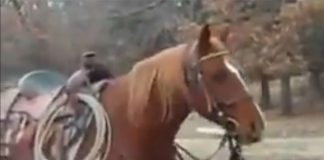Ask anyone what core exercises they typically do, and you’ll probably hear “a lot of crunches.” It seems simple enough—lie on your back with your knees bent and hands laced behind your head, and contract your abdominal muscles as you lift your head and shoulders off the floor. And repeat.
But there’s so much more you can do to develop a stronger core, and there’s so much more to it than just achieving a slimmer waist. It’s also about strengthening your whole body: the abdominal muscles keep the upper and lower body connected. Meaning, if you want to keep your chest and shoulders steady, your core must be steady and strong. Need your legs to stay quiet, thus preventing potential miscues for your horse? You need a strong core.
“Our core is essential to our balance, and so many movements and transitions are directly affected from the balance of the rider,” explains Michael Hunzinger, a Quarter Horse trainer based in Texas.
Here are some movements you can add to your workouts to strengthen your core for a stronger ride from Bridget Braden-Olson, owner of BioRiderFitness.com.
Plank

The plank is the ultimate total-body movement. Hold the “up” push-up position, supporting your bodyweight either on your elbows (directly under your shoulders) and toes, or on the palms of your hands with arms fully extended (hands directly under your shoulders) and toes. Engage your entire body to keep your spine straight (no bend at the waist), and hold the plank for as long as you can. Slowly build up the length of time you can hold that position.
Once you’ve mastered the static plank, it’s time to add difficulty. Doing the lateral twisting plank engages more muscles, including your obliques. Starting in the basic plank position (either on hands or elbows), twist your body to the right, lifting your right hand straight into the air and hold. Repeat to the left. Do 15 twists to each side.

“The core recruits diagonally in this exercise when the arm moves through to reach to the other side,” says Braden-Olson. “Plus, when you reach up toward the sky, your body is placed in a side plank, trigging the obliques to engage. The twisting movement of the arm as it moves in and out of the side plank can cause you to lose your balance, which generates even more core engagement to ensure stability during the rotation.” The muscular engagement you get when doing the lateral twisting plank is similar to what needed for riding.
You can do the lateral twisting plank on a bench, step, hay bale, or BOSU ball for extra difficulty. (A BOSU Ball consists of an inflated rubber hemisphere attached to a hard plastic platform, so it’s like a stability ball cut in half.)
Bridge

Another total-body movement, the bridge will work your hamstrings and glutes, as well as your lower abdominals. To start with the basic position, lie on the floor with your knees bent and feet flat on the ground. Engage your core, glutes, and hamstrings as you lift your pelvis toward the sky and hold for 10 to 15 seconds, then slowly release. Repeat this exercise 10 times.
To add difficulty to the bridge, rest your heels on a stability ball. Start by again lifting your pelvis in the air and holding. You can add hammy curls by rolling the ball toward your buttocks and then back to your heels.
“By adding the curling motion with the hamstrings, the lower core is under stress to keep the hips elevated while rolling the ball to and from the body,” says Braden-Olson. “At this point, your hips will start to collapse and you must engage your lower core to support the pelvis and keep it up. The hammy curls are one of the best exercises for a horseback rider because doing them increases pelvic balance and strength for a better overall core stability in the saddle.”
Toe Taps

There are multiple variations of this exercise, making it great for all levels. The most basic position is to start by sitting in a “V” position on the floor with your back straight, hands behind your head, and your legs bent at 90 degrees. Next, lift your legs up and tap your toes, one at a time, on the floor (like a scissor move). You can twist your upper body so your right elbow touches your left knee, and vice versa, to add a twist to the movement. Add difficulty by doing toe taps on a BOSU Ball.
“The activity in the legs engages the lower abdominal muscles and muscles connecting into the quadriceps,” says Braden-Olson. “Doing these releases any tension that occurs naturally from riding in the hip flexors and lower back, increasing lower core mobility. Increase your core stamina while ensuring you keep an even range of motion in the hips.”
MEGAN ARSZMAN is a freelance writer based in Indiana, where she’s learning to balance motherhood with horses, dogs and writing.
This article originally appeared in the February 2016 issue of Horse Illustrated magazine. Click here to subscribe!






Great tips.
I am going to give these exercises a try.